A clutch is a mechanical device which engages and disengages power transmission especially from driving shaft to driven shaft. The clutch connects the two shafts so that they may be locked together and spin at the same speed (engaged), locked together but spinning at different speeds (slipping) or unlocked and spinning at different speeds (disengaged). Clutches are normally designed as single-plate, twin plate or multi-plate types depending on the number of driven disks.
What Is A Dry Clutch?
A dry clutch as the name suggest, it is a type of clutch that is not bathed in liquid and uses friction to engage. This type of clutch has its plate outside the engine casing. This means that it is in direct contact with the atmosphere and there is no lubrication provided to it. Usually the clutch is larger in size to increase the surface area of the friction plate for optimal air cooling because it does get hot due to friction of the plate. The level of noise in dry clutch is more when compared to that of wet clutch and keeps increasing as the clutch continues to undergo wear and tear.

What You Need To Know About Dry Clutch
- In dry clutch, lubricant is not applied and hence the torque transmitting of these clutches is better.
- This type of clutch has its plate outside the engine casing.
- Dry clutches do not have oil supply and are generally single-plate.
- They are used in less torque situations where frictions levels are low.
- The noise in dry clutch is more when compared to that of wet clutch and keeps increasing as the clutch continues to undergo wear and tear.
- Wear and tear is very much more in dry clutch.
- The dust particles due to wear and tear are collected in the cover of clutch casing.
- The life cycle of a dry clutch is often less when compared to that of wet clutch.
- Maintenance requirement and costs of a dry clutch are high.
- Due to the fact that they are single plate, dry clutches are generally larger in size when compared to multi-plate wet clutches
- Given that they are single plate, dry clutches have a single frictional surface to transmit the power between two plates. Therefore, they do not have a much better coefficient of friction.
What Is A Wet Clutch?
Wet clutches in general have multiple clutch plates (in cars) and have a supply of oil to lubricate and cool the components. The wet clutches are greatly amplified and therefore can cope with much higher torque inputs. In a wet clutch, the lubricating oil keeps surfaces clean and provides smoother performance and longer life.

What You Need To Know About Wet Clutch
- In wet clutch, lubricant is applied to dissipate the heat from the frictional surfaces in contact. The torque transmitting capacity is slightly reduced due to decreased coefficient of friction between the contact surfaces due to the presence of lubricant.
- This type of clutch is located inside the engine casing.
- Wet clutches in general have multiple clutch plates (in cars) and have a supply of oil to lubricate and cool the components.
- They are used in high torque situations where friction levels would be high and therefore clutch temperatures would soar without some form of coolant.
- The noise level in wet clutch is less when compared to dry clutch. The presence of oil between plates helps in managing the noise.
- Wear and tear is very much less in wet clutch.
- The dust particles due to wear and tear are removed by the oil filter present in the clutch casing.
- The life cycle of a wet clutch is often high when compared to that of dry clutch.
- The maintenance requirements and cost of a wet clutch are very much low.
- Given that wet clutches are multi-plate clutches, they are often smaller in size and generally used in applications where there is no enough space to install large single plate clutches (dry clutches).
- Wet clutches provide better coefficient of friction, as the surface area is increased due to the presence of multiple plates.
Difference Between Dry Clutch And Wet Clutch In Tabular Form
| BASIS OF COMPARISON | DRY CLUTCH | WET CLUTCH |
| Description | Lubricant is not applied and hence the torque transmitting of these clutches is better. | Lubricant is applied to dissipate the heat from the frictional surfaces in contact. The torque transmitting capacity is slightly reduced due to decreased coefficient of friction between the contact surfaces due to the presence of lubricant. |
| Type Of Plate | They do not have oil supply and are generally single-plate. | They generally have multiple clutch plates (in cars) and have a supply of oil to lubricate and cool the components. |
| Use | They are used in less torque situations where frictions levels are low. | They are used in high torque situations where friction levels would be high and therefore clutch temperatures would soar without some form of coolant. |
| Noise Level | The noise in dry clutch is more when compared to that of wet clutch and keeps increasing as the clutch continues to undergo wear and tear. | The noise level in wet clutch is less when compared to dry clutch. The presence of oil between plates helps in managing the noise. |
| Wear & Tear | Wear and tear is very much more in dry clutch. | Wear and tear is very much less in wet clutch. |
| Dust Particles | The dust particles due to wear and tear are collected in the cover of clutch casing. | The dust particles due to wear and tear are removed by the oil filter present in the clutch casing. |
| Life Cycle | The life cycle of a dry clutch is often less when compared to that of wet clutch. | The life cycle of a wet clutch is often high when compared to that of dry clutch. |
| Maintenance Requirement & Cost | Maintenance requirement and costs of a dry clutch are high. | The maintenance requirements and cost of a wet clutch are very much low. |
| Size | Dry clutches are generally larger in size when compared to multi-plate wet clutches | They are often smaller in size and generally used in applications where there is no enough space to install large single plate clutches (dry clutches). |
| Coefficient Of Friction | They have a single frictional surface to transmit the power between two plates. Therefore, they do not have a much better coefficient of friction. | They provide better coefficient of friction, as the surface area is increased due to the presence of multiple plates. |
Comments are closed.